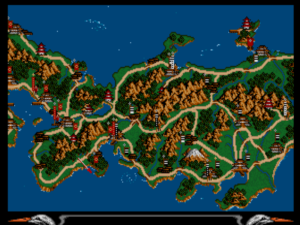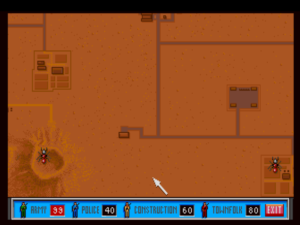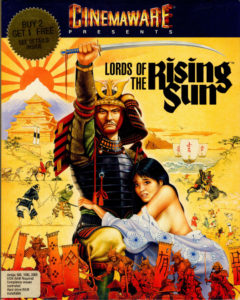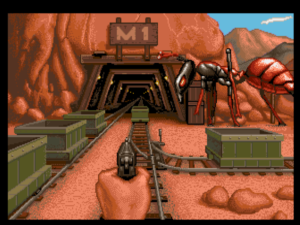The last year of the 1980s was also the last that the Commodore Amiga would enjoy as the ultimate American game machine. Even as the low-end computer-game market was being pummeled into virtual nonexistence by the Nintendo Entertainment System, leaving the Amiga with little room into which to expand downward, the heretofore business-centric world of MS-DOS was developing rapidly on the high end, with VGA graphics and sound cards becoming more and more common. The observant could already recognize that these developments, combined with Commodore’s lackadaisical attitude toward improving their own technology, must spell serious trouble for the Amiga in the long run.
But for now, for this one more year, things were still going pretty well. Amiga zealots celebrated loudly and proudly at the beginning of 1989 when news broke that the platform had pushed past the magic barrier of 1 million machines sold. As convinced as ever that world domination was just around the corner for their beloved “Amy,” they believed that number would have to lead to her being taken much more seriously by the big non-gaming software houses. While that, alas, would never happen, sales were just beginning to roll in many of the European markets that would sustain the Amiga well into the 1990s.
This last positive development fed directly into the bottom line of Cinemaware, the American software house that was the developer most closely identified with the Amiga to a large extent even in Europe. Cinemaware’s founder Bob Jacob wisely forged close ties with the exploding European Amiga market via a partnership with the British publisher Mirrorsoft. In this way he got Cinemaware’s games wide distribution and promotion throughout Europe, racking up sales across the pond under the Mirrorsoft imprint that often dramatically exceeded those Cinemaware was able to generate under their own label in North America. The same partnership led to another welcome revenue stream: the importation of European games into Cinemaware’s home country. Games like Speedball, by the rockstar British developers The Bitmap Brothers, didn’t have much in common with Cinemaware’s usual high-concept fare, but did feed the appetite of American youngsters who had recently found Amiga 500s under their Christmas trees for splashy, frenetic, often ultra-violent action.
Yet Cinemaware’s biggest claim to fame remained their homegrown interactive movies — which is not to say that everyone was a fan of their titular cinematic approach to game-making. A steady drumbeat of criticism, much of it far from unjustified, had accompanied the release of each new interactive movie since the days of Defender of the Crown. Take away all of the music and pretty pictures that surrounded their actual game play, went the standard line of attack, and these games were nothing but shallow if not outright broken exercises in strategy attached to wonky, uninteresting action mini-games. Cinemaware clearly took the criticism to heart despite the sales success they continued to enjoy. Indeed, the second half of the company’s rather brief history can to a large extent be read as a series of reactions to that inescapable negative drumbeat, a series of attempts to show that they could make good games as well as pretty ones.
At first, the new emphasis on depth led to decidedly mixed results. Conflating depth with difficulty in a manner akin to the way that so many adventure-game designers conflate difficulty with unfairness, Cinemaware gave the world Rocket Ranger as their second interactive movie of 1988. It had all the ingredients to be great, but was undone by balance issues exactly the opposite of those which had plagued the prototypical Cinemaware game, Defender of the Crown. In short, Rocket Ranger was just too hard, a classic game-design lesson in the dangers of overcompensation and the importance of extensive play-testing to get that elusive balance just right. With two more new interactive movies on the docket for 1989, players were left wondering whether this would be the year when Cinemaware would finally get it right.
Certainly they showed no sign of backing away from their determination to bring more depth to their games. On the contrary, they pushed that envelope still harder with Lords of the Rising Sun, their first interactive movie of 1989. At first glance, it was a very typical Cinemaware confection, a Defender of the Crown set in feudal Japan. Built like that older game from the tropes and names of real history without bothering to be remotely rigorous about any of it, Lords of the Rising Sun is also another strategy game broken up by action-oriented minigames — the third time already, following Defender of the Crown and Rocket Ranger, that Cinemaware had employed this template. This time, however, a concerted effort was made to beef up the strategy game, not least by making it into a much more extended affair. Lords of the Rising Sun became just the second interactive movie to include a save-game feature, and in this case it was absolutely necessary; a full game could absorb many hours. It thus departed more markedly than anything the company had yet done from Bob Jacob’s original vision of fast-playing, non-taxing, ultra-accessible games. Indeed, with a thick manual and a surprising amount of strategic and tactical detail to keep track of, Lords of the Rising Sun can feel more like an SSI than a typical Cinemaware game once you look past its beautiful audiovisual presentation. Reaching for the skies if not punching above their weight, Cinemaware even elected to include the option of playing the game as an exercise in pure strategy, with the action sequences excised.
But sadly, the strategy aspect is as inscrutable as a Zen koan. While Rocket Ranger presents with elegance and grace a simple strategy game that would be immensely entertaining if it wasn’t always kicking your ass, Lords of the Rising Sun is just baffling. You’re expected to move your armies over a map of Japan, recruiting allies where possible, fighting battles to subdue enemies where not. Yet it’s all but impossible to divine any real sense of the overall situation from the display. This would-be strategy game ends up feeling more random than anything else, as you watch your banners wander around seemingly of their own volition, bumping occasionally into other banners that may represent enemies or friends. It suffers mightily from a lack of clear status displays, making it really, really hard to keep track of who wants to do what to whom. If you have the mini-games turned on, the bird’s-eye view is broken up by arcade sequences that are at least as awkward as the strategy game. In the end, Lords of the Rising Sun is just no fun at all.

While it’s very pretty, Lords of the Rising Sun‘s animated, scrolling map is nicer to look at than it is a practical tool for strategizing.
Press and public alike were notably unkind to Lords of the Rising Sun. Claims like Bob Jacob’s that “there is more animation in Lords than has ever been done in any computer game” — a claim as unquantifiable as it was dubious, especially in light of some of Sierra’s recent efforts — did nothing to shake Cinemaware’s reputation for being all sizzle, no steak. Ken St. Andre of Tunnels & Trolls and Wasteland fame, reviewing the game for Questbusters magazine, took Cinemaware to task on its every aspect, beginning with the excruciating picture on the box of a cowering maiden about to fall out of her kimono; he deemed it “an insult to women everywhere and to Japanese culture in particular.” (Such a criticism sounds particularly forceful coming from St. Andre; Wasteland with its herpes-infested prostitutes and all the rest is hardly a bastion of political correctness.) He concluded his review with a zinger so good I wish I’d thought of it: he called the game “a Japanese Noh play.”
Many other reviewers, while less boldly critical, seemed nonplussed by the whole experience — a very understandable reaction to the strategy game’s vagaries. Sales were disappointing in comparison to those of earlier interactive movies, and the game has gone down in history alongside the equally underwhelming S.D.I. as perhaps the least remembered of all the Cinemaware titles.
So, what with the game-play criticisms beginning to affect the bottom line, Cinemaware really needed to deliver something special for their second game of 1989. Thankfully, It Came from the Desert would prove to be the point where they finally got this interactive-movie thing right, delivering at long last a game as nice to play as it is to look at.
It Came from the Desert was the first of the interactive movies not to grow from a seed of an idea planted by Bob Jacob himself. Its originator was rather David Riordan, a newcomer to the Cinemaware fold with an interesting career in entertainment already behind him. As a very young man, he’d made a go of it in rock music, enjoying his biggest success in 1970 with a song called “Green-Eyed Lady,” a #3 hit he co-wrote for the (briefly) popular psychedelic band Sugarloaf. A perennial on Boomer radio to this day, that song’s royalties doubtless went a long way toward letting him explore his other creative passions after his music career wound down. He worked in movies for a while, and then worked with MIT on a project exploring the interactive potential of laser discs. After that, he worked briefly for Lucasfilm Games during their heady early days with Peter Langston at the helm. And from there, he moved on to Atari, where he worked on laser-disc-driven stand-up arcade games until it became obvious that Dragon’s Lair and its spawn had been the flashiest of flashes in the pan.
Riordan’s resume points to a clear interest in blending cinematic approaches with interactivity. It thus comes as little surprise that he was immediately entranced when he first saw Defender of the Crown one day at his brother-in-law’s house. It had, he says, “all the movie attributes and approaches that I had been trying to get George Lucas interested in” while still with Lucasfilm. He wrote to Cinemaware, sparking up a friendship with Bob Jacob which led him to join the company in 1988. Seeing in Riordan a man who very much shared his own vision for Cinemaware, Jacob relinquished a good deal of the creative control onto which he had heretofore held so tightly. Riordan was placed in charge of the company’s new “Interactive Entertainment Group,” which was envisioned as a production line for cranking out new interactive movies of far greater sophistication than those Cinemaware had made to date. These latest and greatest efforts were to be made available on a whole host of platforms, from their traditional bread and butter the Amiga to the much-vaunted CD-based platforms now in the offing from a number of hardware manufacturers. If all went well, It Came from the Desert would mark the beginning of a whole new era for Cinemaware.

Here we can see — just barely; sorry for this picture’s terrible fidelity — Cinemaware’s scripting tool MasterPlan.
Cinemaware spent months making the technology that would allow them to make It Came from the Desert. Riordan’s agenda can be best described as a desire to free game design from the tyranny of programmers. If this new medium was to advance sufficiently to tell really good, interesting interactive stories, he reasoned, its tools would have to become something that non-coding “real” writers could successfully grapple with. Continuing to advance Cinemaware’s movie metaphors, his team developed a game engine that could largely be “scripted” in point-and-click fashion in HyperCard rather than needing to be programmed in any conventional sense. Major changes to the structure of a game could be made without ever needing to write a line of code, simply by editing the master plan of the game in a HyperCard tool Cinemaware called, appropriately enough, MasterPlan. The development process leveraged the best attributes of a number of rival platforms: Amigas ran the peerless Deluxe Paint for the creation of art; Macs ran HyperCard for the high-level planning; fast IBM clones served as the plumbing of the operation, churning through compilations and compressions. It was by anyone’s standards an impressive collection of technology — so impressive that the British magazine ACE, after visiting a dozen or more studios on a sort of grand tour of the American games industry, declared Cinemaware’s development system the most advanced of them all. Cinemaware had come a long way from the days of Defender of the Crown, whose development process had consisted principally of locking programmer R.J. Mical into his office with a single Amiga and a bunch of art and music and not letting him out again until he had a game. “If we ever get a real computer movie,” ACE concluded, “this is where it’s going to come from.”
While it’s debatable whether It Came from the Desert quite rises to that standard, it certainly is Cinemaware’s most earnest and successful attempt at crafting a true interactive narrative since King of Chicago. The premise is right in their usual B-movie wheelhouse. Based loosely on the campy 1950s classic Them!, the game takes place in a small desert town with the charming appellation of Lizard Breath that’s beset by an alarming number of giant radioactive ants, product of a recent meteor strike. You play a geologist in town; “the most interesting rocks always end up in the least interesting places,” notes the introduction wryly. Beginning in your cabin, you can move about the town and its surroundings as you will, interacting with its colorful cast of inhabitants via simple multiple-choice dialogs and getting into scrapes of various sorts which lead to the expected Cinemaware action sequences. Your first priority is largely to convince the townies that they have a problem in the first place; this task you can accomplish by collecting enough evidence of the threat to finally gain the attention of the rather stupefyingly stupid mayor. Get that far, and you’ll be placed in charge of the town’s overall defense, at which point a strategic aspect joins the blend of action and adventure to create a heady brew indeed. Your ultimate goal, which you have just fifteen days in total to accomplish, is to find the ants’ main nest and kill the queen.
It Came from the Desert excels in all the ways that most of Cinemaware’s interactive movies excel. The graphics and sound were absolutely spectacular in their day, and still serve very well today; you can well-nigh taste the gritty desert winds. What makes it a standout in the Cinemaware catalog, however, is the unusual amount of attention that’s been paid to the design — to you the player’s experience. A heavily plot-driven game like this could and usually did go only one way in the 1980s. You probably know what I’m picturing: a long string of choke points requiring you to be in just the right place at just the right time to avoid being locked out of victory. Thankfully, It Came from the Desert steers well away from that approach. The plot is a dynamic thing rolling relentlessly onward, but your allies in the town are not entirely without agency of their own. If you fail to accomplish something, someone else might just help you out — perhaps not as quickly or efficiently as one might ideally wish, but at least you still feel you have a shot.
And even without the townies’ help, there are lots of ways to accomplish almost everything you need to. The environment as a whole is remarkably dynamic, far from the static set of puzzle pieces so typical of more traditional adventure games of this era and our own. There’s a lot going on under the hood in this one, far more than Cinemaware’s previous games would ever lead one to expect. Over the course of the fifteen days, the town’s inhabitants go from utterly unconcerned about the strange critters out there in the desert to full-on, backs-against-the-wall, fight-or-flight panic mode. By the end, when the ants are roaming at will through the rubble that once was Lizard Breath destroying anything and anyone in their path, the mood feels far more apocalyptic than that of any number of would-be “epic” games. One need only contrast the frantic mood at the end of the game with the dry, sarcastic tone of the beginning — appropriate to an academic stranded in a podunk town — to realize that one really does go on a narrative journey over the few hours it takes to play.
Which brings me to another remarkable thing: you can’t die in It Came from the Desert. If you lose at one of the action games, you wake up in the hospital, where you have the option of spending some precious time recuperating or trying to escape in shorter order via another mini-game. (No, I have no idea why a town the size of Lizard Breath should have a hospital.) In making sure that every individual challenge or decision doesn’t represent a zero-sum game, It Came from the Desert leaves room for the sort of improvisational derring-do that turns a play-through into a memorable, organic story. It’s not precisely that knowledge of past lives isn’t required; you’re almost certain to need several tries to finally save Lizard Breath. Yet each time you play you get to live a complete story, even if it is one that ends badly. Meanwhile you’re learning the lay of the land, learning to play more efficiently and getting steadily better at the action games, which are themselves unusually varied and satisfying by Cinemaware’s often dodgy standards. There are not just many ways to lose It Came from the Desert but also many paths to victory. Win or lose, your story in It Came from the Desert is your story; you get to own it. There’s a save-game feature, but I don’t recommend that you use it except as a bookmark when you really do need to do something else for a while. Otherwise just play along and let the chips fall where they may. At last, here we have a Cinemaware interactive movie that’s neither too easy nor too hard; this one is just right, challenging but not insurmountable.

It Came from the Desert evolves into a strategy game among other things, as you deploy the town’s forces to battle each new ant infestation while you continue the search for the main hive.
Widely and justifiably regarded among the old-school Amiga cognoscenti of today as Cinemaware’s finest hour, It Came from the Desert was clearly seen as something special within Cinemaware as well back in the day; one only has to glance at contemporary comments from those who worked on the game to sense their pride and excitement. There was a sense both inside and outside their offices that Cinemaware was finally beginning to crack a nut they’d been gnawing on for quite some time. Even Ken St. Andre was happy this time. “Cinemaware’s large creative team has managed to do a lot of things very well indeed in this game,” he wrote, “and as a result they have produced a game that looks great, sounds great, moves along at a rapid pace, is filled with off-the-wall humor without being dumb, and is occasionally both gripping and exciting.”
When It Came from the Desert proved a big commercial success, Cinemaware pulled together some ideas that had been left out of the original game due to space constraints, combined them with a plot involving the discovery of a second ant queen, and made it all into a sequel subtitled Ant-Heads!. Released at a relatively low price only as an add-on for the original game — thus foreshadowing a practice that would get more and more popular as the 1990s wore on — Ant-Heads! was essentially a new MasterPlan script that utilized the art and music assets from the original game, a fine demonstration of the power of Cinemaware’s new development system. It upped the difficulty a bit by straitening the time limit from fifteen days to ten, but otherwise played much like the original — which, considering how strong said original had been, suited most people just fine.
It Came from the Desert, along with the suite of tools used to create it, might very well have marked the start of exactly the new era of more sophisticated Cinemaware interactive movies that David Riordan had intended it to. As things shook out, however, it would have more to do with endings than beginnings. Cinemaware would manage just one more of these big productions before being undone by bad decisions, bad luck, and a changing marketplace. We’ll finish up with the story of their visionary if so often flawed games soon. In the meantime, by all means go play It Came from the Desert if time and motivation allow. I was frankly surprised at how well it still held up when I tackled it recently, and I think it just might surprise you as well.
(Sources: The One from April 1989, June 1989, and June 1990; ACE from April 1990; Commodore Magazine from November 1988; Questbusters from September 1989, February 1990, and May 1990; Matt Barton’s interview with Bob Jacob on Gamasutra.)















Alex Smith
October 14, 2016 at 4:30 pm
I know mileage can vary on idioms and all, but did you perhaps mean to label Dragon’s Lair the “flashiest of flashes in the pan”? That would be more typical I think.
Jimmy Maher
October 14, 2016 at 4:57 pm
Miss Malaprop’s got nothing on me sometimes. Thanks!
Lisa H.
October 14, 2016 at 5:19 pm
Looks like he’s already fixed it, so I’m curious what it said before!
Jimmy Maher
October 14, 2016 at 7:20 pm
“Splash” instead of “flash” in the pan…
Captain Rufus
October 14, 2016 at 10:42 pm
To be fair compared to what Japanese computers had and have for content, teen boy attracting sideboob on Rising Sun is a microscopic level of offense.
This isn’t exactly a good thing mind you but in comparison to what Japan did and still does most of a breast exposed is far down the DUDE NO totem pole compared to all the vile disgusting crap Japanese computer games love to sell themselves on.
It makes a certain US presidential candidate look like a feminist in comparison. Which should be IMPOSSIBLE. And that’s just what I have heard of or seen reviewed/read outrage at.
There is always more and it is always worse.
Oddly enough St. Andre’s tabletop publisher to this day actually licensed their battle book Lost Worlds game to what is infamously known as Queen’s Blade. And imported some of the books to be sold on their web shop. It is mighty far from progressive too. Unless combat game books where anime women have what little clothing and armor they wear ripped off in full color detail is considered progressive. (I would say no. Not at all.)
Jimmy Maher
October 15, 2016 at 6:38 am
Ken St. Andre suddenly deciding to take the stance he did on Lords of the Rising Sun did strike me as odd, especially given that he spent a fair amount of time slavering over the various female romantic prospects on offer in It Came from the Desert in his review of that game just a few months later. But it’s so rare to see anyone in the industry even acknowledging that these issues exist in this era that I’m always tempted to highlight it when I do see it.
Captain Rufus
October 15, 2016 at 7:11 pm
Ive noted that Andre and the Flying Buffalo crew did take some less than positive things out of their older Tunnels and Trolls products when they did the semi recent new edition. Which was good.
Alexander Freeman
October 15, 2016 at 10:42 pm
The cynic in me suspects St. Andre simply saw an opportunity to take the high ground against someone he was in competition with. It doesn’t sound as though he had much room to talk.
Carl
October 14, 2016 at 11:20 pm
It Came From the Desert was the only game save Shadow of the Beast that actually impressed my Nintendo-loving friends. Along with Wings (my favorite Cinemaware game) It Came From the Desert raised the enjoyment level (at least for me as a teenager) by actually having fun action sequences. Wings (which I do hope you cover) kind of flipped the balance by making the action sequences the best part and the story kind of secondary.
I had no idea Cinemaware used Hypercard as a development tool. I played around a lot with Hypercard and made some truly dreadful adventure games of my own using it…
Way to jog some memories I haven’t accessed in a decade or more, Jimmy!
Jimmy Maher
October 15, 2016 at 6:30 am
Wings is actually most interesting to me for the story. It’s just about the only simulator ever to define “realism” as making some sort of effort to show the real human toll of war, which I find rather noble and inspiring, even if the tragic parts are mixed up with plenty of “rah-rah!” chest-thumping as well. But the actual *game* part of it all strikes me as pretty rote, and wears out its welcome long before you’ve played all 200 missions or whatever it is.
But anyway… yes, will definitely be covering it quite soon. In fact, I have something kind of special planned for it.
Carl
October 15, 2016 at 1:08 am
I was poking around youtube trying to find a longplay of It Came From the Desert and I came across this:
https://www.youtube.com/watch?v=c-J6GMLtpq8&ab_channel=Roger!Pictures
Looks like (based on the facebook page) the film is currently shooting. I must admit the teaser is kind of weak but it is fascinating Cinemaware (or whatever entity owns the name) appears to be involved…
Jubal
October 15, 2016 at 1:48 am
“Even as the low-end computer-game market was being pummeled into virtual nonexistence by the Nintendo Entertainment System, leaving the Amiga with little room into which to expand downward”
This is probably a significant factor in the Amiga’s success in Europe, actually – although the NES was around, console gaming never really took off here in Britain until the release of the SNES and Megadrive/Genesis, by which time the Amiga had had time to become THE home computer of choice.
Jimmy Maher
October 15, 2016 at 6:25 am
Yes, it was a huge factor. The Amiga came to occupy a niche at the mid-level and (eventually) low-end in Europe that was completely dominated by consoles in North America. Had Nintendo not come along, American youngsters with Commodore 64s might have moved gradually to the Amiga 500, as many did in Europe. Instead they all got Nintendos, Segas, (a little later) PlayStations, etc. The only computer-gaming market left was the high-end MS-DOS machines.
Jubal
October 16, 2016 at 10:26 am
I’m curious now as to just why the 8-bit consoles never had so much of an impact here as in the US. I’d never really thought about it before.
Felix
October 17, 2016 at 6:18 am
@Jubal In Europe, 8-bit consoles had to compete with 8-bit computers that were both cheaper and more fun to play with, since you could also tinker — mostly ZX Spectrum clones (often unauthorized), which meant there was a single market for games. And games were sold on cassette tapes (no need for expensive disk drives!) that, owning to a lack of copyright protections in Eastern Europe before and after 1990, often came with up to 10 titles a side.
A Famicom, even a cheap South Asian clone, simply didn’t come close to competing on price. (The Master System was nearly unheard of.) And that was *after* the Iron Curtain fell, by which point everyone equated computing with the 8-bit micros that used to be the only option.
Of course, half of that didn’t really apply in Western Europe. Or did it?
J Griffin
October 17, 2016 at 11:50 pm
Price was a major factor. The NES launched, in the UK at least, with what seemed like astronomical prices compared to what we were used to. You could spend about 1.99 to 10.99 on an 8-bit home computer game, or something like 39.99 for a NES cart (about 70-80 bucks in 1980s U.S dollars). It was simply priced far out of the range of most kids, and the rental backbone U.S gamers got to enjoy just didn’t exist yet. It really took until the 16-bits for rental to come in and allow the poorer kids to play, along with systems becoming ubiquitous enough for trading your couple of games between your friends to be a thing.
It’s worth noting Sega were always considerably better on pricing in europe, which is a big part of why the Master System was the only 8-bit console to get any foothold at all in the UK, albeit a fairly small one. Still quite expensive for the time though.
Kaitain
October 17, 2016 at 9:57 pm
People in the UK had always (in the 80s) bought into the idea of computing being an enthusiast activity that encompassed gaming but also creativity and programming. This may have been spurred in part by the country being so hard-up in the late 70s and early 80s, and therefore unable to treat gaming as a purely consumer activity: it was simply too expensive to buy dedicated games machines, especially ones whose games came on cartridge. But I suspect there’s more to it than that…Britain has long had a kind of tinkerer’s culture spanning from make-do-and-mend to full-on invention. Sinclair played a part in this: cheap, cheerful machines where you needed to get your hands a bit dirty to get up and running, and where a lot of people’s first games were typed in from magazine listings.
So you can look at the Amiga’s success from the perspective of it filling a niche that was left by the country’s lack of interest in consoles. But you can also approach the analysis from the other end, and say that the Amiga ticked all the boxes for the enthusiast culture in the UK whereas consoles did not.
Lisa H.
October 15, 2016 at 4:12 am
Widely and justifiably regarded among the old-school Amiga cognizanti
Cognoscenti?
Jimmy Maher
October 15, 2016 at 6:19 am
YES! I looked forever for the correct spelling and couldn’t find it. Thanks!
Michael Davis
October 15, 2016 at 6:29 pm
Boy, something must have been lost in the translation process when porting It Came From The Desert to MS-DOS, because I HATED that game. Granted, I was pretty young, so maybe my hand-eye coordination wasn’t where it needed to be, but all I remember is that the pistol never did ANYTHING to the ants, so I always ended up in the hospital after every encounter, and it was impossible to make it even a few seconds into the hospital escape mini-game, so I always had to stay the full duration in the hospital. So after just a few rounds of that, the ants more or less had control of the city and it was all over but the crying. All I ever did in that game was lose.
And that was when I was at an age where all my birthday money or all my Christmas money would barely buy one game, so I only got one or two new games a year, and I felt like I had been royally screwed with that purchase.
Jimmy Maher
October 15, 2016 at 7:04 pm
The trick with the ants is to shoot their antenna. But yeah, sounds like something was off. Never played the MS-DOS version myself.
Ironically, the MS-DOS port was done by Level 9, the former British text-adventure makers, as one of their last projects before closing up shop.
Pedro Timóteo
October 16, 2016 at 9:09 am
The DOS version is basically the Amiga version with EGA graphics, no digitized sounds, and Adlib or Roland MT-32 music / “sound”. The game is exactly the same (and load times are probably better – I didn’t play a lot of it), but the Amiga graphics and, especially, music make up a big part of the original’s atmosphere, and that is lost here.
Pedro Timóteo
October 16, 2016 at 10:50 am
Correction: it *has* digitized sounds (both Sound Blaster and PC speaker, the latter being used if you choose Roland MT-32 music). I had assumed it hadn’t, because there’s no voiced intro.
The music is terrible, though, IMO, both with Adlib / Sound Blaster selected and with MT-32. It has none of the atmosphere from the Amiga, sounding more like “elevator music”, and either sound card could do a lot better.
Michael Davis
October 16, 2016 at 1:35 pm
Well, in this video of a DOS play session, at the 8-minute mark you can see the first encounter with an ant, and see how either A. the game makes it impossible, or B. this player is just as bad as I was, because that’s exactly how I remember it: shooting wildly around, never coming close to hitting the antennas, and winding up in the hospital every damn time: https://www.youtube.com/watch?v=YE41rtQZofY
In this longplay video of the Amiga version, the player has that same encounter on the farm at the 3:30 mark, shoots off both antennas within the first couple attempted shots, and then successfully fends off the multiple-ant attack during the overhead camera section as well (something I also was never able to do in the DOS game): https://www.youtube.com/watch?v=KTWd_eyAmgQ
So either the Amiga version was more forgiving, or the controls were more responsive, or, again, maybe I was just a crappy player, but I remember kicking myself for making it my one big game purchase that year. Also, to add insult to injury, the DOS game box had Amiga screenshots on the back (http://www.mobygames.com/game/dos/it-came-from-the-desert/cover-art/gameCoverId,832/). If the EGA graphics I ended up with had been on the box I definitely wouldn’t have bought it :P
Eric
October 17, 2016 at 11:56 am
Michael, you describe exactly what I remember my experience of the game was.
I’m pretty sure I ended up understanding that the antenna were the weak point, but still it was impossible to shoot them. On the video you point to, it seems clear that there is a delay between the moment the player pulls the trigger and the gun actually fires.
I also remember something about grenades that were pretty hard to aim at the ants.
Anyway, like you said: awful memories of an unplayable game.
stepped pyramids
May 27, 2017 at 4:04 am
There was also an absolutely terrible “port” to the TurboGrafx-CD which cannibalized a couple of the minigames and paired it with some new, terrible minigames and a completely new plot based around FMV sequences that feel like the film project of high school students who just watched Blue Velvet and Twin Peaks for the first time.
Alexander Freeman
October 15, 2016 at 10:44 pm
Come to think of it, I’d say Adrift is a better comparison to Hypercard than AdvSys is as far as interactive fiction systems go.
CdrJameson
October 18, 2016 at 11:12 pm
Having just had a go at this for the first time ever (Amiga version, Cinemaware colection) the knife fighting seems hilariously weird.
Apparently they’re fighting with some kind of toothpick or pencil, based on the damage it does with each hit. But that’s not too bad because you can seem to stab your opponent indefinitely by hitting up and fire at which point your main obstacle becomes hand cramp.
And despite having shot the antennae off a giant ant, grenaded half a dozen of the blighters and got more mucus, reports and plaster-casts than you can shake a stick at the mayor STILL doesn’t believe me. What’s a guy to do?
Jimmy Maher
October 19, 2016 at 9:24 am
You need four unique pieces of evidence. Have you talked to the guy at the airport yet, and has he told you about his new tape recorder? I believe he usually gets it around day 5.
bryce777
April 9, 2017 at 4:08 pm
I liked It Came From The Desert. Not an incredible game but it really felt like you were in a movie.
Wolfeye M.
September 28, 2019 at 2:34 am
I’ll have to get the Cinemaware Collection, when I have the spending money. Just for that game, because I love cheesy 50s sci-fi movies, like Them. And the art style definitely still holds up, I like it a lot.
Derek
September 6, 2020 at 2:43 am
Giant ants from space
snuff the human race.
Then they eat your face,
never leave a trace.
— Chris Stein
Jonathan O
May 25, 2022 at 10:16 pm
Another typo that’s been lying around for ages: “…whether this would the year when Cinemaware would finally get it right.”
Jimmy Maher
May 27, 2022 at 6:41 am
Thanks!
Steve Pitts
February 15, 2023 at 5:21 pm
“especially in itself in light of”
is that what you intended to say or was a sentence partly rewritten but not properly cleaned up. It sort of makes sense but reads really awkwardly to my eyes.
Jimmy Maher
February 16, 2023 at 8:31 am
No, it’s a error. Thanks!
Ben
January 2, 2024 at 9:50 pm
pretty, Lords -> [Lords in italics]
Jimmy Maher
January 3, 2024 at 5:18 pm
Thanks!
Carlo Savorelli
January 19, 2025 at 10:57 am
I’m reading those Questbusters issues again, and it seems to me that the monthly journal had some trouble adjusting to the rapidly diversifying world of “adventures” (their impossibly late coverage of Faery Tale Adventure might also be an early indicator of this). Now, besides the breasts talk, St. Andre’s piece opens with a warning: “Because they’re so much like interactive movies, even a CinemaWare game that’s basically a wargame will be of at least passing interest to real adventurers. So we’ll take a quick look at Lords”.
It’s a brief note taking less than a column, and the author seems especially irked by the fact that the in-game credits don’t list a game designer (except, the manual does, as we know). Then there’s a mandatory tirade of “style over substance” that will be repeated for Cinemaware’s later efforts. In the end, there does seem very little consideration for the wargame aspects. The point I’m making is that this was probably not the publication to look at searching for an expertise. Nowadays the game has its share of estimators, on Steam, EAB and elsewhere, and the portrait given here of an unfathomable mess doesn’t seem to be a balanced view.
I know, I know, Barnett and the unzorkiness of Return to Zork… But “the sins of the child shall not be visited upon his father”, or so they say.
Busca
August 10, 2025 at 7:28 pm
While I understand the 2017 film broadly based on the concept of It Came from the Desert is eminently missable, has anyone here checked out the 2023 homage (?) game It Returned to the Desert (almost 50% cheaper on itch.io than on Steam)?
For any German speakers interested in It Came from the Desert and its background/development, including a look at B movies it built on, the retro podcast Stay Forever’s recent coverage of it (2h29, but you can jump (to) any of the many chapters, if you prefer) might make a good complement to Jimmy’s article.